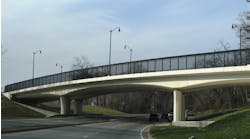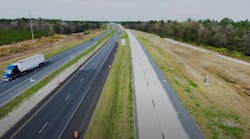Tunnelers in California worked carefully forward until, on Nov. 29, 2011, the crews from Oakland on the west end and Orinda on the east broke through to form a continuous open passage.
They had to dig carefully, because the rock of the East Bay Hills, separating Alameda and Contra Costa counties, is fractured and requires support.
The tunnelers were familiar with the conditions, since this tunnel is the fourth bore of the Caldecott Tunnel through the East Bay Hills to add lanes to S.R. 24. The first two bores—one for each direction of traffic—opened in 1937. The third opened to traffic in 1964 and made it possible to switch the direction of traffic in the middle bore so four lanes were always available for the heavier traffic flow and two lanes served the lighter flow.
The fourth bore project is a partnership between the Federal Highway Administration, the California Department of Transportation (Caltrans), the Metropolitan Transportation Commission, the Contra Costa Transportation Authority and the Alameda County Transportation Commission.
The $390 million project is primarily funded through the American Recovery and Reinvestment Act of 2009 ($180 million); through a local transportation sales tax (Measure J) passed by Contra Costa voters in 2004; and by Regional Measure 2 (Bay-area bridge tolls).
When the fourth bore opens to traffic in 2013, it will eliminate the need to reverse the traffic twice a day in the middle bore and dedicate four lanes each to westbound and eastbound traffic. It will accommodate two 12-ft traffic lanes, with a 10-ft shoulder on the north side and a 2-ft shoulder on the south.
Because of the fractured nature of the rock, the contractor, Tutor-Saliba Corp., has employed a 130-ton Wirth roadheader to dig from the east end, while a modified Caterpillar 330 excavator digs from the west end. The roadheader was used to break through the final wall of rock about 200 meters from the west end of the tunnel. A tunnel-boring machine was not appropriate for this project in part because the fractured rock could have potentially collapsed around it and impeded progress.
With the roadheader, the contractor can dig forward a meter or two at a time, spray shotcrete 8-10 in. thick onto the walls and ceiling, install other measures to support the newly exposed rock and then continue digging. The support measures needed depend on the properties of the rock, which can change from one round to the next.
It takes a support system
“The support measures include rock dowels that are radial to the tunnel alignment, shotcrete, which is just sprayed-on concrete reinforced with plastic fibers,” Bill Bornman, a construction manager at Caltrans, told Roads & Bridges. “They use lattice girders, which are steel trusses that go against the excavated rock to help stabilize it. In some categories of the rock they have to install spiles, which are steel dowels that go at an angle forward where we have not yet excavated in order to stabilize the ground above the tunnel. They’re installed ahead of where we’ve already excavated so that when we excavate the next round they support the newly excavated ground until the shotcrete can be applied.”
Employing this process, called the New Austrian Tunneling Method, or the Sequential Excavation Method, they advanced between 1 meter a day where the rock was very hard and up to 4.2 meters where the rock was soft.
“It utilizes the natural distribution of stresses in the ground to help stabilize the tunnel. It’s not like they used to do tunnel excavation a hundred years ago, when . . . they tried to support all the loads with huge timbers. Now we actually use the ground to help support itself by installing these other measures.”
The tunnel is a total of 990 meters long. When it is finished it will be 15 meters wide and 11-12.3 meters high with a roadway clearance of 5.1 meters. The part now excavated, what they call the “topheading,” is not that high. Tutor-Saliba still has what it calls the “bench” below the topheading to excavate. The contractor will follow the same sequential method to excavate and support the bench.
The diggers also do periodic testing of the rock they are about to dig into.
“Every day, they would evaluate the rock that they encountered in the previous excavation,” Bornman said. “We have geologists that look at the face of the newly exposed rock and determine what that’s like. Periodically, they would do test cores ahead to see if they were getting into weaker rock or stronger rock as they moved forward to try and anticipate what was going to happen a meter from now, two meters from now. They could guess what support needed to be installed.”
The bare ground is self-supporting for some period of time, and the crews apply shotcrete as soon as possible.
“In some areas of the tunnel, we had to excavate in portions,” Bornman said, “and the reason we did that is because the ground was not self-supporting long enough to excavate the entire width and then apply shotcrete.
“I anticipate that we’ll have some issues with that during the bench excavation. We’ll excavate the side of the tunnel, get enough room that they can get in there with their shotcrete equipment and spray it with shotcrete before they excavate it the whole way across.
“There were no cave-ins or anything like that. We had some areas where there was overbreak, which is just where there was more material than we wanted to excavate that came down, but no catastrophic failures or anything like that.”
The breakthrough took place about 200 meters from the western portal, but unfortunately the conditions inside precluded a ceremony marking the event. Even in the 21st century, tunneling is a dirty business, especially in a passage classified as “gassy” by the California Occupational Safety and Health Administration.
Out with the old;
in with the new
“When you’re excavating, you can hit pockets of gas in the rock that you’re digging through,” Bornman explained, but once it dissipates, it is not a problem. After the tunnel is lined and finished, there should be no gas entering it.
Now that the excavation has broken through from one end to the other, there will be some natural ventilation because of atmospheric differences between the two ends of the tunnel.
“In the summer, the west side is cooler and the east side is warmer, so you have a natural air flow in the tunnel,” said Bornman. “We also have ventilation systems that deal with the exhaust produced by the cars, for example. Our ventilation systems handle that with no problem.”
All workers in the tunnel have to wear a respirator near the rock face during excavation.
When the excavation is complete, they will smooth out the shotcrete, which is a concrete mix with small aggregate and sand but not large aggregate.
Shot in the dark
“Before we could start doing the shotcrete, we had to have the mix design approved,” said Bornman, “and they had to demonstrate to us that it could be applied successfully in the geometric configuration of the tunnel. They had to mock up a ceiling and walls, and they had to spray it. We also do continuous testing to make sure that it gets the properties that it needs to stabilize the ground.”
Over the top of the smoothed shotcrete is applied a waterproofing membrane 7 mm thick made of a polymer-based material. For the final lining of the tunnel, the contractor will cast a wall of reinforced concrete by assembling a cage of rebar, constructing formwork to contain the concrete and pouring the concrete through holes in the forms and then plugging the holes when the wall space is filled. They will do the casting in sections about 15 meters long. When one section is set, they will advance the formwork and cast the next section.
The driving surface for the tunnel will be 285 mm of jointed plane concrete pavement over 150 mm of lean concrete base over 300 mm of aggregate sub-base.The rock will sit on top of the in-situ rock of the tunnel except in a few areas such as the first 60 meters in from the west portal.
“The first 60 meters of the tunnel from the west,” said Bornman, “they had to excavate below the structural section level and place shotcrete to close the perimeter of the tunnel. That’s because the ground is relatively weak in that area.”
With any tunnel, there is the question of how to make sure you are digging in the right direction.
“When they were excavating, they had lasers that were fixed to the walls of the tunnel that showed them where to dig,” Bornman said. “They would shine a green dot on the face so the roadheader operator could excavate to those green dots and know that he was where he was supposed to be.
“For most of its alignment, the tunnel is straight. It was fairly easy for them to control rough alignment with the lasers. Then when they got done excavating, they came in with a scanner and it would tell them how much they actually excavated. It would give them a 3-D profile of the tunnel. They also had surveyors who would come in and survey the alignment as they moved forward.”
The west tunnel broke through only 5 mm vertically and 13 mm horizontally away from the east tunnel.
“I figured they were going to be close,” Bornman commented, “but to be within half an inch one way and a quarter of an inch the other way is pretty good.” R&B


